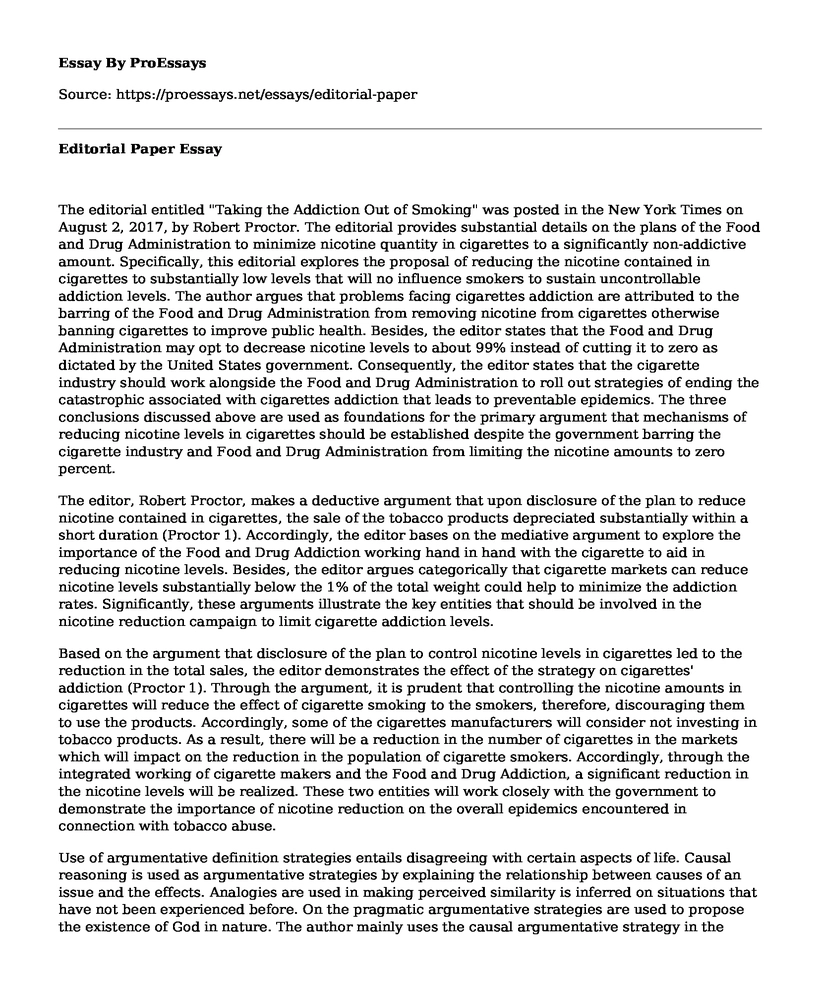The editorial entitled "Taking the Addiction Out of Smoking" was posted in the New York Times on August 2, 2017, by Robert Proctor. The editorial provides substantial details on the plans of the Food and Drug Administration to minimize nicotine quantity in cigarettes to a significantly non-addictive amount. Specifically, this editorial explores the proposal of reducing the nicotine contained in cigarettes to substantially low levels that will no influence smokers to sustain uncontrollable addiction levels. The author argues that problems facing cigarettes addiction are attributed to the barring of the Food and Drug Administration from removing nicotine from cigarettes otherwise banning cigarettes to improve public health. Besides, the editor states that the Food and Drug Administration may opt to decrease nicotine levels to about 99% instead of cutting it to zero as dictated by the United States government. Consequently, the editor states that the cigarette industry should work alongside the Food and Drug Administration to roll out strategies of ending the catastrophic associated with cigarettes addiction that leads to preventable epidemics. The three conclusions discussed above are used as foundations for the primary argument that mechanisms of reducing nicotine levels in cigarettes should be established despite the government barring the cigarette industry and Food and Drug Administration from limiting the nicotine amounts to zero percent.
The editor, Robert Proctor, makes a deductive argument that upon disclosure of the plan to reduce nicotine contained in cigarettes, the sale of the tobacco products depreciated substantially within a short duration (Proctor 1). Accordingly, the editor bases on the mediative argument to explore the importance of the Food and Drug Addiction working hand in hand with the cigarette to aid in reducing nicotine levels. Besides, the editor argues categorically that cigarette markets can reduce nicotine levels substantially below the 1% of the total weight could help to minimize the addiction rates. Significantly, these arguments illustrate the key entities that should be involved in the nicotine reduction campaign to limit cigarette addiction levels.
Based on the argument that disclosure of the plan to control nicotine levels in cigarettes led to the reduction in the total sales, the editor demonstrates the effect of the strategy on cigarettes' addiction (Proctor 1). Through the argument, it is prudent that controlling the nicotine amounts in cigarettes will reduce the effect of cigarette smoking to the smokers, therefore, discouraging them to use the products. Accordingly, some of the cigarettes manufacturers will consider not investing in tobacco products. As a result, there will be a reduction in the number of cigarettes in the markets which will impact on the reduction in the population of cigarette smokers. Accordingly, through the integrated working of cigarette makers and the Food and Drug Addiction, a significant reduction in the nicotine levels will be realized. These two entities will work closely with the government to demonstrate the importance of nicotine reduction on the overall epidemics encountered in connection with tobacco abuse.
Use of argumentative definition strategies entails disagreeing with certain aspects of life. Causal reasoning is used as argumentative strategies by explaining the relationship between causes of an issue and the effects. Analogies are used in making perceived similarity is inferred on situations that have not been experienced before. On the pragmatic argumentative strategies are used to propose the existence of God in nature. The author mainly uses the causal argumentative strategy in the article. Through this strategy, the author urges the Food and Drug Administration together with the cigarette makers to focus on a measure that would reduce nicotine amounts in cigarettes to prevent the epidemics which result from smoking (Proctor 1). Precisely, the author uses the causal argumentative strategy to compare the fatalities which result from cigarette smoking such as preventable diseases as well as deaths. Therefore, these factors may be prevented by reducing the addiction rates through decreased nicotine percentage in the cigarettes. As a result, the author urges the government and other organizations to prevent the resultant conditions due to increased cigarette smoking.
The author uses both statistics and figurative analogies to support the causal argumentative strategy. He argues that by 2050, close to 17 million Americans could die as a result of cigarette smoking (Proctor 1). This is considerably a huge number that can be controlled by reducing the amount of nicotine in tobacco products. Accordingly, the author urges cigarette companies to invest in alternatives of traditional cigarettes by discussing the $3 billion expenditure by Philip Morris in advocating for the post-cigarette economy (Proctor 1). Moreover, the author employs a figurative analogy to compare the 10 percent reduction factor of the percentage weight of nicotine contained in cigarettes. Therefore, reducing the nicotine levels would be reducing the addiction rates leading to minimized risks of cigarette smoking.
The editorial's argument may be reasonably applied in reducing the number of cigarette smoking addictions. Throughout the editorial, the author provides enough information to support the claims made. He uses statistical data to illustrate the number of death that result from nicotine health impacts and the monetary figure that can be invested to reduce investment in nicotine-free cigarettes. The argument portrays fewer flaws as long as the willing organizations invest in the idea of reducing nicotine percentages in cigarettes.
Work Cited
Proctor, Robert N. "Taking the Addition Out of Smoking" The New York Times, 2 Aug. 2017. Retrieved from: <https://www.nytimes.com/2017/08/02/opinion/fda-smoking-nicotine.html>
Cite this page
Editorial Paper. (2022, Nov 02). Retrieved from https://proessays.net/essays/editorial-paper
If you are the original author of this essay and no longer wish to have it published on the ProEssays website, please click below to request its removal:
- The Threat of Comprehensive Overstimulation in Modern Societies Essay
- 1MDB Scandal Essay Example
- Gun Control Issues Essay
- State Courts in Florida - Essay Sample
- The Great Recession: 10 Years of Economic Disparity - Essay Sample
- Mercure Brighton Seafront Hotel: 1824 Grade II Listed, Restaurant, Bar, Weddings & Events - Essay Sample
- Free Research Paper Example on Myths and Mythology







